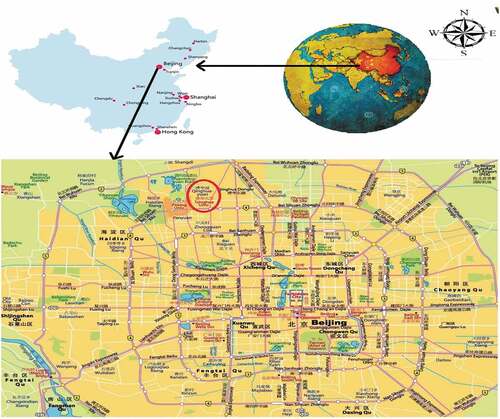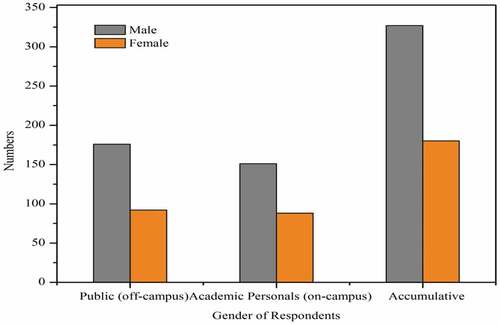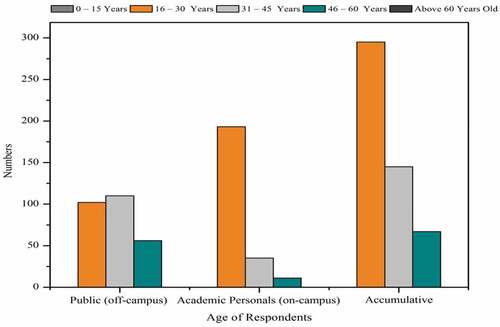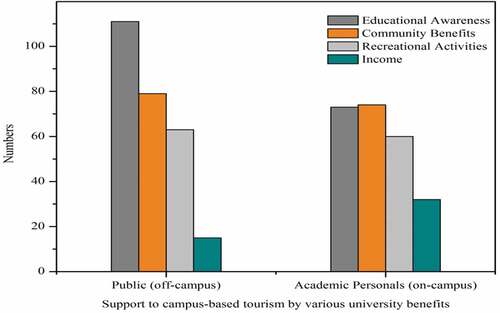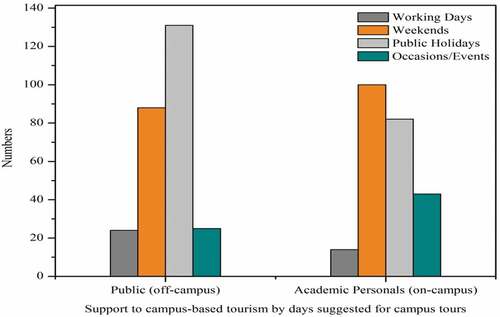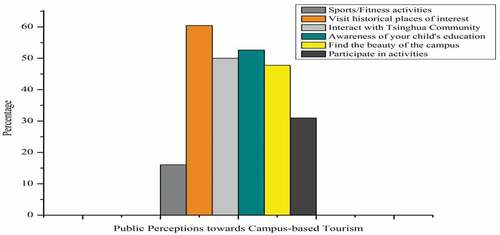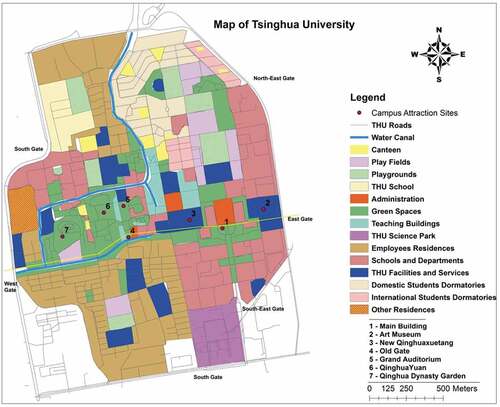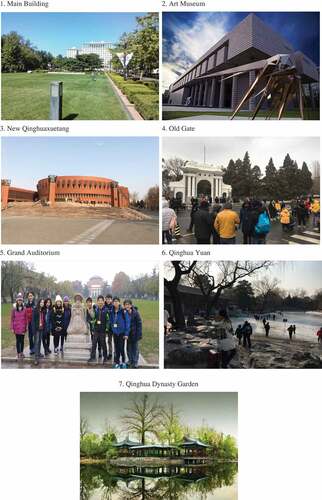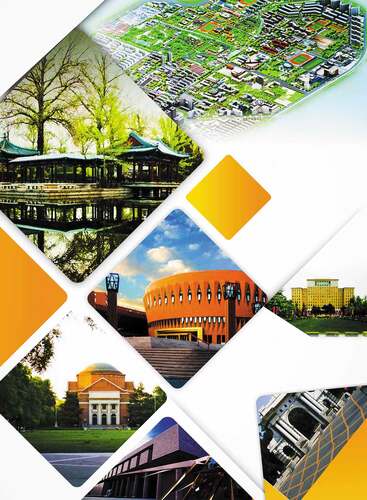Abstract
University is not only considered as an academic institution but it also plays a key role in the promotion of local tourism. The purpose of this study is to promote campus-based tourism and bring certain socio-economic benefits along with academic atmosphere. This paper has examined the campus tourism characteristics, desirability level of public (off-campus) and academic personals’ (on-campus) satisfaction. Tsinghua University, Beijing, China is selected to study the existing trend and socio-economic benefits of campus-based tourism. The data are collected from both local public or tourist (off-campus) and academic personals (on-campus) by questionnaire survey individually. The obtained data are analyzed in SPSS software. Finding the respondents perceptions’ significant impact to support the campus-based tourism, an ANOVA (analysis of variances) test is conducted. ANOVA test results indicated that there is mainly statistically significant impact between the groups of public (off-campus) and academia (on-campus). The ArcGIS software is also used and generated map to observe various famous tourism sites within campus. More specifically, the study outcomes revealed that mostly public and academic personals are mutually supporting to the development of campus-based tourism.
PUBLIC INTEREST STATEMENT
Worldwide, university campus is considered as an additional component of modern tourism industry. Campus tourism is a special form of urban culture tourism. While university is an integrated platform of science, culture, human resources and the knowledge with profound historical, traditional and aesthetical landscapes. Thus; university become favorite tourism spot for public, young students and parents, i.e. China. Public mostly prefer to visit the world renowned universities like Tsinghua University for giving educational awareness, motivation and amusing from historical and cultural places. Though, campus tourism demand has increased but become controversial issue in China when tourists banned by Peking and Tsinghua universities due to disturbance in academic activities. Therefore, this study has conducted. The Study aimed to promote campus tourism getting socio-economic benefits. Campus-based tourism perceptions were taken from both local public (off-campus) and academia (on-campus). Results found that both communities (off-campus and on-campus) are mutually supporting to campus tourism but should be organized appropriately.
1. Introduction
The trend of modern tourism industry has been accelerated since end of World War. At present, it is considered as most powerful industry in the world (Zhi-Gui, Citation2011). Tourism adapts at higher priority of human needs and deals with essential requirements that boost the country economy (Zhi-Gui, Citation2011). In modern tourism, University campus is widely discussed and become an additional component of tourism industry (Ming, Citation2007; Wei, Citation2009), which is also been an effective part and extension of urban tourism (Hong, Mei-Rong, & Yang-Ying, Citation2005). University campus tourism is counted as an important form and content of urban cultural tourism (Hong et al., Citation2005; Pan, Jiayu, & Qianru, Citation2011; Zhi-Gui, Citation2011). The campus tourism is a special form of tourism (Ming, Citation2007; Xiao-Ping, Li-Ping, & Yong-Bin, Citation2007), which represents urban development trends at present and it will be a backbone of urban tourism in future (Hong et al., Citation2005; Zhi-Gui, Citation2011).
University is an integrated platform of science, culture, human resources and the knowledge. University has a long history of its deep historical, traditional, scenic aesthetical, natural and cultural landscapes and the endless charm of memories (Jian, Yin-Guan, & Zhang, Citation2005; Ling, Citation2000). For scientific, technological, and cultural awareness and the importance of higher education, university has to be open up to outside public regularly (Jian et al., Citation2005). However, public would also like to arrange university visits to enjoy the places of interest, aware from the educational environment and taste the culture, etc. Worldwide, many well-known universities are attracting public by their campus aesthetics, historic buildings, museums, bookstores, cultural activities, folk arts, painting and calligraphy exhibitions, etc., and also utilizing all resources to promote campus tourism gently (Zhi-Gui, Citation2011). Campus tourism basically refers to visit the higher learning institutions’ unique architecture, aesthetic scenery, rich cultural heritage and academic atmosphere that bring socio-economic benefits (Pan et al., Citation2011; Zhi-Gui, Citation2011). The university campus is a hub of activities that serve not only students and staff community but also surrounding localities with its concert halls, museums, sports stadiums, landscaped grounds, and various yearly events. Thus, it provides an environment for learning along with public spaces for getting amusement (Gumprecht, Citation2007).
Campus tourism became very familiar in the world. Currently, it is quite mature in world-renowned universities like Harvard University, Stanford University, Massachusetts Institute of Technology (MIT), University of Cambridge, University of Oxford, Paris University and University of Toronto, etc. All these universities are open for outside communities. These universities are facilitating the local residents by providing good and comfortable places to get amuse form scenic views that must be visited locally (Kun & Jun- Hua, Citation2017). Some of these universities allowed local public to visit their campuses without any special permission. In 1980s, about four million people traveled to Cambridge every year to visit the campus, 55% of which are foreigners and 110 million pounds tourism revenue generated annually (Zhi-Gui, Citation2011) which has been increased today.
In the case of China, Universities’ campuses are considered as a local tourism brand (Ming, Citation2007; Xiao-Ping et al., Citation2007) in various provinces, i.e. Beijing, Shanghai, Zhejiang, Nanjing, etc. Presently, they have become favorite tourism destinations for local public, young students and their parents. This trend is continuously increasing. The renowned institutions of higher learning, campus beautiful environment, sophisticated equipments, and advanced laboratories pull the people to visit their children for educational awareness, feeling university culture and courage them to compete and avail the opportunities in future (The Beijinger [TB], Citation2017). Therefore, Tsinghua and Peking are one of those world leading China’s universities which always remained top preference of Chinese people. Every year, tens of thousands of tourists visit Tsinghua University (Kun & Jun- Hua, Citation2017). Especially in summer holidays, Tsinghua University bears approximately 3000 visitors per day and allows them for tourism activities (Zhao, Citation2017). On the other hand, campus tourism has long been a controversial issue and profoundly debated in China. In Peking University, teachers and students complained about noisy crowds disrupting academic atmosphere during tourism activities inside campus earlier. University administration imposed the ban on tourism activities within campus that also came under debate at the national level (Daily China [DC], Citation2017). Though, recently it is still a controversial issue in China. However, many Chinese people still believe that universities’ campuses should be open to the general public (Daily China, Citation2017; Kun & Jun- Hua, Citation2017). Thus, Universities should pay more attention to provide enough open spaces and public interest sightseeing, which will not only meet the desires of local public but also promote campus culture (Zhao, Citation2017).
In the end, this study is carried out to investigate people perceptions regarding campus-based tourism. This study may lead to support in the publicity of campus-based tourism getting socio-economic benefits including educational awareness, community motivation and income generation, and also experiencing rich campus culture in China. Rest of the paper is discussed accordingly; study area, research methodology, study results, discussion and conclusion.
2. Campus tourism in Tsinghua university and top six universities of the world
Tsinghua University is one of the world leading universities and top university of China. It is placed at 17th in the QS World University Rankings of 2019. Table illustrates the comparison of Tsinghua University with top six universities of the world in QS ranking as of 2019 (www.topuniversities.com) to know the existing trend of campus tourism in different world renowned universities. The information was taken from universities’ official websites, i.e. MIT, Stanford University, Harvard University, California Institute of Technology (Caltech), University of Oxford, University of Cambridge and Tsinghua University. The world famous universities have a proper mechanism and departments to organize and manage the campus tours affectivity but Tsinghua University is still behind to arrange such tourism activities adequately (Zhao, Citation2017).
Table 1. Campus tourism comparison among world top ranked universities with Tsinghua University
3. Material and methods
3.1. Material
Tsinghua University is one of the well-reputed universities in China and a world-leading university. It is situated in the northwest of Beijing at 40° 00ʹ 0.00” N latitude, 116° 19ʹ 21.60” E longitude coordinates as indicated in Figure . University Campus is laid on the former imperial gardens of Qing Dynasty site with surrounded land covered by many historical places (Tsinghua University [THU], Citation2017). The campus academics, residential and recreation uses are expended over 395 ha (980 acres) area as shown in Figure . Tsinghua is also enlisted the only university of Asia as one of most beautiful campuses globally by a notable panel of campus design scholars in Forbes 2010. Besides, the old campus of Tsinghua University is also characterizing American holiday campus. The historic buildings are constructed with western brickwork style (Kun & Jun- Hua, Citation2017).
Figure 2. Detailed map of Tsinghua University (The Tsinghua University, Citation2017).
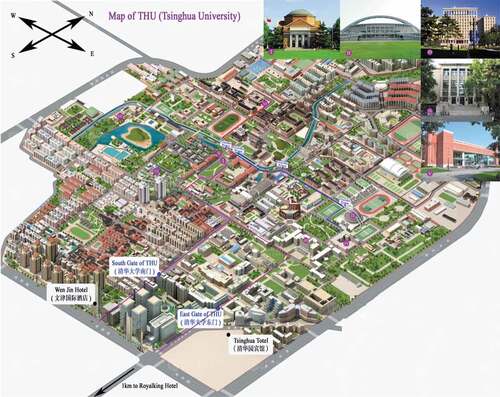
3.2. Methods
Campus tourism is highly demanded and top prioritized by public in China (Zhi-Gui, Citation2011). It is long debated and paid attention to scholars in the field of research at China. Therefore, a detailed study was carried-out on campus-based tourism. Research Methodology was designed to conduct the study for targeting research objectives (prescribed in Section 1) (Malik, Asmi, Ali, & Rahman, Citation2018). Methods are elucidated briefly as follows:
3.2.1. Questionnaire and sample size
The data were obtained using a questionnaire survey. Two separate structured questionnaires (Hossini, Azemati, Elyasi, & Mozaffar, Citation2015; Jian et al., Citation2005; Law & Chon, Citation2007) were designed based on research indicators. Questionnaire attributes were overviewed by a group of tourism academicians and representatives of campus administration (Aksu, İçigen, & Ehtiyar, Citation2010). The series of questions were compiled as close-ended including multiple choices and five-point Likert scale ranging from “strongly agree = 1” to “strongly disagree = 5” (Emir & Arslanturk, Citation2015; Masa’deh, Nasseef, Alshayeb, Ojilat, & Alshafiee, Citation2017). Questionnaires were formulated in both Chinese and English languages (Aksu et al., Citation2010). Sample size of questionnaires was set concerning with population using popular small sample technique presented by Krejcie and Morgan (Citation1970). For the questionnaire survey, two types of people were targeted, i.e. academic personals (on-campus) and local Chinese people or tourist (off-campus). From the academia mostly questions were asked to identify students and staff satisfaction level about campus tourism circulations. Similarly, the level of desirability of outside campus community was measured by public side questionnaire. Moreover, questionnaires were filled through online (Zhao, Citation2017) and on-site surveys. For online survey, WJX (www.wjx.cn) website was used to formulate questionnaires. Links were mailed to different WeChat (online software application) academic personals and local public chat groups (Law & Chon, Citation2007; McKecher, Law, & Lam, Citation2006). However, total 507 people were responded in this survey; out of which 239 were academia (students and staff) and 268 local public or tourist. Respondents shared their views about campus-based tourism, especially for Tsinghua University. Besides, existing site conditions were also investigated by the on-site survey.
3.2.2. Data variables
The obtained questionnaire data were segregated with respect to independent and dependent variables. Respondents’ gender, age groups and their education were taken as independent variables (Masa’deh et al., Citation2017). However, people perceptions about supporting campus-based tourism development, avoid the ban on campus tours, opinions about academic disturbance, get tourism benefits and days suggested for campus visits by local public or tourist (off-campus) and academic personals (on-campus) were set as dependent variables. Further, analysis of data is briefly stated in the next segment.
3.2.3. Data analysis
The study data were analyzed using Statistical Package for Social Sciences (SPSS.22) software. Descriptive statistics (Hossini et al., Citation2015; Law & Chon, Citation2007; Omifolaji, Taiwo, & Modu, Citation2015) was performed to analyze the data. In order to examine the impact of campus tourism for supporting campus-based tourism development, respondents’ perceptions were evaluated through 5-point Likert scale (Dudensing, Hughes, & Shields, Citation2011; Emir & Arslanturk, Citation2015; Masa’deh et al., Citation2017). One-way ANOVA model (Byrd, Bosley, & Dronberger, Citation2009; Chiu-Hui & Meen-Tsai, Citation2017; Masa’deh et al., Citation2017; Zhang, Li, Su, & Hu, Citation2017) was applied to measure the significant impact of variables. Additionally, for tourism attractions site analysis, Geographical Information System (ArcGIS 10.2.3) online software was used to identify the existing tourist attraction spots (Kang, Lee, Kim, & Park, Citation2018) at Tsinghua University.
3.2.3.1. Variables significant impact model
In order to test the significant impacts of public desirability and academia willingness, analysis of variances (ANOVA) model was carried-out. One-way ANOVA (Tukey post hoc) (Byrd et al., Citation2009; Chiu-Hui & Meen-Tsai, Citation2017; Masa’deh et al., Citation2017; Zhang et al., Citation2017) technique was employed to measure the statistical significant difference between independent and dependent variables. The variables data were analyzed by significant mean difference value at 0.05 level (i.e. p = 0.05) (Chiu-Hui & Meen-Tsai, Citation2017; Masa’deh et al., Citation2017). Variables results revealed less than 0.05 0r P < 0.05 (significant mean difference value) are considered as significance. However, more than or equal to 0.05 (P ≥ 0.05) are counted as non-significance (Chiu-Hui & Meen-Tsai, Citation2017; Masa’deh et al., Citation2017). Variables tables contained results of ANOVA test are discussed in the next section.
4. Results
In this study, the authors have mainly investigated the impacts of campus tourism in terms of socio-economic impacts on support to campus-based tourism development at Tsinghua University, Beijing, China. Views were taken from two different groups of respondents as general public or tourist (off-campus) and academic personals (on-campus) related to campus-based tourism and its publicity individually. Five hundred seven people were participated in this survey, in which 268 were local public (off-campus) and 239 were academic personals (on-campus). The ratio of male and female participants was 64% (327) and 36% (180) as indicated in Figure . Information was gathered from 16 to 60 years or above age groups of respondents, wherein 295 people (58%) were in between 16–30 years old, 145 (29%) were 31–45 years old and 67 persons (13%) were 46–60 years old, respectively. Mostly 16–30 years old people were contributed, as shown in Figure . People who shared their views regarding campus tourism were having different educational level such as 83 (16%) were Ph.D., 161 (32%) post-graduate, and 254 (50%) were undergraduate as prescribed in Figure .
Figure 7. Public and academic personals’ support to organize campus visits instead of the ban by campus management.
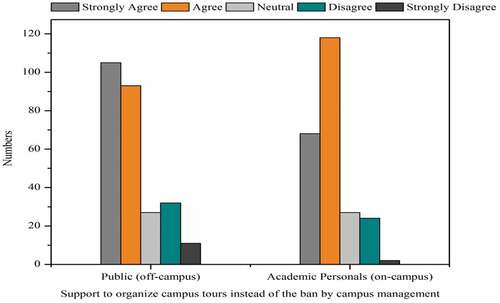
4.1. Analysis of variances (ANOVA) model
A one-way analysis of variances compared the response given by local people and academic personals separately regarding open up of Tsinghua University campus to outside public. The response was measured based on respondents’ education level to get appropriate information. Three groups of opinions are ranked by people who participated in a survey that how much they are agreed for campus-based tourism as shown in Figure . Table illustrates the result of three different response categories; the first category is for people who are agreed, second for disagreed and third category for those who are neither agreed nor disagreed. Analysis of table data indicates that both the public (off-campus) and academia (on-campus) response is statistically significant (p = 0.003 and 0.001 or p < 0.05) (Chiu-Hui & Meen-Tsai, Citation2017; Masa’deh et al., Citation2017). There is a significant positive impact on supporting campus-based tourism.
Table 2. ANOVA analysis impact on support to campus-based tourism by general public (off-campus) and academic personals (on-campus)
Similarly, Table expresses the respondents’ perceptions about organizing tours instead of completely restricting public to visit the campus. Five-point Likert scale-based response was marked by participants. Scale levels were categorized as strongly agreed, agreed, neutral (neither agreed nor disagreed), disagreed and strongly disagreed as illustrated in Figure . Analysis of variances shows that the value between groups of public (off-campus) as well as academic personals (on-campus) is statistically significant (p = 0.000 and 0.016 or p < 0.05) (Chiu-Hui & Meen-Tsai, Citation2017; Masa’deh et al., Citation2017), which means that there is a positive significant impact to organize campus-based tourism. Hence, both public and academic communities are mutually in favor to open up the campus and organize tours instead of completely ban by campus management.
Table 3. ANOVA analysis impact on support to organize campus tours instead of the ban by campus management
Simultaneously, Table ANOVA comparisons analysis shows public and academic personals opinions about campus tours that make disturbances in the academic environment. The different views were sorted out into 5-Likert scale categories and ranked by respondents as strongly agree, agree, neutral, disagree and strongly disagree, respectively as shown in Figure . Table data analysis specifies that the value between groups of public (off-campus) opinions is statistically significant but academia (on-campus) is not statistically significant (p = 0.001 or p < 0.05 and p = 0.472 or p > 0.05) (Chiu-Hui & Meen-Tsai, Citation2017; Masa’deh et al., Citation2017). ANOVA result shows that public (off-campus) disagree with raised statement that campus tourism may create disturbances in academic environment, while academic personals (on-campus) are thinking that tourist circulation may create disturbances inside campus during academic activities.
Table 4. ANOVA analysis impact on academic disturbances during campus tourism
Tables and expound targeted people opinions’ regarding campus-based tourism benefits. A one-way analysis of variances using Tukey test was compared the opinions of public (off-campus) and academic personals (on-campus) individually. The opinions were measured considering a variable of respondents’ perceptions related to open up university for tourism, as; to know that if the campus may open for tourism than what kind of benefits University may get? Table data emphasize various benefits that Tsinghua University may get from tourism services. Four types of campus tourism benefits were categorized for ranking the most essential university advantages, i.e. educational awareness, community motivations, promoting recreational activities and income generation as indicated in Figure . ANOVA Tukey test analysis elaborates that the public (off-campus) response values between category 1 (educational awareness) and 2 (community motivation) as well as category 1 (educational awareness) and category 3 (recreational activities) are having statistically significant impact (p = 0.000 or P < 0.05 and p = 0.008 or p < 0.05), but, the values between category 4 (income) and other three categories (educational awareness, community motivation and recreational activities) do not have significant impact (p = 0.402, 0.802, 0.994 or p > 0.05) (Chiu-Hui & Meen-Tsai, Citation2017; Masa’deh et al., Citation2017), as mentioned in Table . However, in the case of academic personals (on-campus), the values between group 1 (educational awareness) and group 2 (community motivation) as well as group 1 (educational awareness) and group 3 (recreational activities) are statistically significant (p = 0.030 or P < 0.05 and p = 0.000 or p < 0.05), while the values between category 4 (income) and remaining three categories (educational awareness, community motivation and recreational activities) are not having significant impact (p = 0.125, 0.999, 0.644 or p > 0.05) (Chiu-Hui & Meen-Tsai, Citation2017; Masa’deh et al., Citation2017) as illustrated in Table . Results revealed that the university probably may get advantages of educational awareness, community motivations and some-how promoting recreational activities by campus tourism.
Table 5. ANOVA analysis impact on support to campus-based tourism by various university benefits (off-campus public)
Table 6. ANOVA analysis impact on support to campus-based tourism by various university benefits (on-campus academic personals)
Besides; perceptions regarding campus visit days were also taken from public (off-campus) and academic personals (on-campus). Tables and brief the information about campus visit days suggested by public and academic personals. Various campus visit days were segregated into four groups such as working days, weekends, public holidays and special occasions, and marked by participants at their desires accordingly as pointed out in Figure . The data analysis specifies that the public (off-campus) desires values between group 1 (working days) and other three (2, 3 and 4) groups (weekends, public holidays and occasions/events) are not statistically significant (p = 0.173, 0.994, 0.452 or P > 0.05); however, group 2 (weekends) values with group 3 (public holidays) and group 4 (occasions/events) are having significant impact (p = 0.001 and 0.001 or p < 0.05) (Chiu-Hui & Meen-Tsai, Citation2017; Masa’deh et al., Citation2017) as pointed out in Table . Meanwhile; as for academic personals concern, the values between category 1 (working days) and remaining all three (2, 3 and 4) categories (weekends, public holidays and occasions/events) are not statistically significant (p = 0.994, 0.239, 0.107 or p > 0.05), but category 2 (weekends) values with category 3 (public holidays) and category 4 (occasions/events) are statistically significant (p = 0.009 and 0.004 or p < 0.05) as shown in Table . Results found that mostly weekends, public holidays and some special occasion’s days are suggested by local public and academic personals for campus visits and both are mutually supported to allow visitors in these days at Tsinghua University.
Table 7. ANOVA analysis impact on support to campus-based tourism by days suggested for campus tours
Table 8. ANOVA analysis impact on support to campus-based tourism by days suggested for campus tours
Additionally, apart from the off-campus public, attitude towards campus-based tourism was confirmed by asking multiple choices. Majority of them had shown their interest for visiting Tsinghua University in order to see campus beauty (48%), give educational awareness to children (53%), interaction with Tsinghua academic community (50%) and to know the history of campus (60%), respectively, as indicated in Figure .
4.2. Tourism attractions site analysis
Tsinghua University is one of the world-renowned higher educational institutes, which has not only the friendly educational environment but also keeps pleasant scenic areas. It is also very famous as a tourism site in Beijing nowadays. People like to visit the campus when they come to Beijing across China and other world countries too. Although; Campus has many areas of interests but there are mainly seven major spots which attract the visitors such as main administration building, art museum, new Qinghuaxuetang, old gate, grand auditorium, Qinghua yuan, and Qinghua dynasty garden, respectively, as pointed out in Figure . These areas are also interconnected to each other with adequate accessibility from east to west direction. Yellow line indicates the path from where tourists will come and leave the campus after sightseeing without making disturbances in the educational environment. Analysis of the figure shows that there is enough provision of campus-based tourism; however, there is need to manage tourism activities inside campus. Thus; university administration should come forward and play a vital role to organize and promote campus-based tourism.
5. Discussion
The data were collected using questionnaire survey. The information was gathered from both local public (off-campus) and academic personals (on-campus). Total 507 persons were participated in this survey and shared their views about campus tourism. Majority of them were male (64%) respondents. The survey participants’ were in between 16 to 60 years age groups, mostly (58%) were between 16–30 years age and 30–45 years old were at second (29%). All these respondents were having higher education or enrolled in undergraduate (50%), postgraduate (32%) and Ph.D. (16%) studies. Moreover, research findings revealed that both public (off-campus) and academic personals (on-campus) (p = 0.003 and p = 0.001 or p < 0.05) are mutually demanding to open up Campus for the outside public (Bin, Citation2004; Kun & Jun- Hua, Citation2017; Ming, Citation2007). Local people have keen interest to visit Tsinghua University, a world-renowned institution for the sake of their children educational awareness (53%), motivation (50%), exploring historical facts (60%) and self-amusement (48%). Students and staff have some reservations because campus-based tourism creates disturbance in academic activities (p = 0.472 or p > 0.05). Campus visits should be organized instead of the ban by campus administration (Guan-Wen, Citation2008) confessed by public (off-campus) and academic (on-campus) communities (p = 0.000 and p = 0.016 or p < 0.05). Concerned authority has necessary to organize and promote sustainable campus-based tourism which does not only serve the visitors but academic society too. For this purpose, respondents also mutually suggested weekends, public holidays and other special occasions or events for outside public to visit the campus. Tsinghua University is one of the world esteemed and China’s top university with rich in cultural tourism sites. Tsinghua has great potential of campus-based tourism but there is need to organize and manage tourism activities appropriately. Resultantly, University will publicize and promote its campus culture to the outside public and provide better opportunity to explore it.
6. Conclusion
The universities’ campuses are considered as a local tourism brand (Ming, Citation2007; Xiao-Ping et al., Citation2007) and have become most favorite tourism spots in China. However, campus tourism has been long controversial issue and under debated in China after imposing ban on tourism activities inside campus by Peking and Tsinghua Universities, Beijing due to academics’ disturbances by noisy crowd (Daily China, Citation2017). Though, campus tourism is still controversial issue in China but most of the Chinese people believe that universities should open for local public (Daily China, Citation2017; Kun & Jun- Hua, Citation2017). In this context, Quantitative study was conducted to find out both public (off-campus) desires and academic (on-campus) community satisfactory conditions about campus-based tourism. Further knowing the facts, Tsinghua University, Beijing as Chinas’ top ranked and one of the world renowned universities was taken case study.
This study concluded that the campus-based tourism importance has been increasing domestically as well as globally. Public often wants to visit renowned universities existed in their towns or cities (Zhi-Gui, Citation2011). People come to such institutions/campuses aiming to visit cultural education heritage, interact with academic communities, give educational awareness to their children, and to get amuse from aesthetic scenic spots particularly in China. The campus should always open up for the local public. Instead of restricting local tourists, Tsinghua university administration should manage tours within campus (Guan-Wen, Citation2008). Moreover, the administration has necessary to provide a better framework for campus-based tourism and make proper arrangements for outside tourists along with academic communities (inside campus). It will reduce the chances of any disturbance which may create during campus tourism circulation. It is also necessary that campus management should establish the tourism department to organize such tourism activities in Tsinghua University. Tourism department should be an autonomous body which will completely be responsible to provide and control campus-based tourism. In addition, Tsinghua is the world-leading university. Every person has a dream to come and study in such a prominent university not only in China but also in other countries. Therefore, Tsinghua University should come forward and put a remarkable stone for providing proper campus-based tourism services especially in the case of China which is not done before in past by academic institutions. Lastly, further research may be conducted regarding opening up policy and administrative framework for campus-based tourism in future.
Correction
This article has been republished with minor changes. These changes do not impact the academic content of the article.
Acknowledgements
We would like to thank ZHU Wenyi, professor of School of Architecture, Tsinghua University, Beijing, China who assigned the research task. We also appreciate the contribution of LONG Ying, associate professor of Urban Planning Department, Tsinghua University for providing geodatabase of the Campus. Especially thank to Noman Sahito, assistant professor of City and Regional Department, Mehran University of Engineering and Technology, Pakistan who assisted in proofreading of this paper.
Additional information
Funding
Notes on contributors
Muhammad Yousif Mangi
Muhammad Yousif Mangi, Doctoral student of Department of Urban Planning, School of Architecture, Tsinghua University, Beijing, China. He did his master and undergraduate in the field of City and Regional Planning. His research interests are including urban settlements planning and development, socio-economic development and urban land uses.
Zhang Yue
Zhang Yue, Professor and Vice Chair of Department of Urban Planning, School of Architecture, Tsinghua University. He is also visiting scholar of Harvard University. He is certified Master's and Ph.D. supervisor. His doctoral degree is in Urban Planning and Design. His research interests are included urban-rural planning and design, socio-economic development and human settlements planning.
Saima Kalwar
Dr. Saima Kalwar, Assistant Professor in the Department of City and Regional Planning, Mehran University of Engineering and Technology, Pakistan. She has completed Ph.D. from University of Malaya. Her research interest is in the field of built environment, secondary cities, regional economy and tourism.
References
- Aksu, A., İçigen, T., & Ehtiyar, R. (2010). A comparison of tourist expectations and satisfaction: A case study from antalya region of Turkey. Turizam, 14(2), 66–26. doi:10.5937/Turizam1002066A
- The Beijinger. (2017, October 9). http://www.thebeijinger.com/blog/2017/08/11/hoping-give-children-competitive-edge-visiting-tourist-overwhelm-tsinghua-peking.
- Bin, M. (2004). The analysis of university campus planning based on tourism characteristic. New Architecture, 6, 68–70.
- Byrd, E. T., Bosley, H. E., & Dronberger, M. G. (2009). Comparisons of stakeholder perceptions of tourism impacts in Rural Eastern North Carolina. Tourism Management, 30(5), 693–703. doi:10.1016/j.tourman.2008.10.021
- California Institute of Technology (Caltech). (2019, February 11). http://www.caltech.edu/content/visit
- Chiu-Hui, H., & Meen-Tsai, W. (2017). The influence of tourism dependency on tourism impact and development support attitude. Asian Journal of Business and Management, 5(2), 88–96.
- Daily China. (2017, October 3). http://www.chinadaily.com.cn/china/2017-05/16/content_29367916.htm
- Dudensing, R. M., Hughes, D. W., & Shields, M. (2011). Perceptions of tourism promotion and business challenges: A survey-based comparison of tourism businesses and promotion organizations. Tourism Management, 32(6), 1453–1462. doi:10.1016/j.tourman.2010.10.008
- Emir, O., & Arslanturk, Y. (2015). Perceptions of tourism students on thermal tourism in Afyonkarahisar. Procedia-Social and Behavioral Sciences, 176, 565–570. doi:10.1016/j.sbspro.2015.01.511
- Guan-Wen, R. (2008). A brief discussion on the responsibilities of college tourism colleges and departments in campus tourism. Tourism Forum, 19(6), 458–461.
- Gumprecht, B. (2007). The campus as a public space in the American College Town. Journal of Historical Geography, 33(1), 72–103. doi:10.1016/j.jhg.2005.12.001
- Harvard University. (2019, February 11). https://www.harvard.edu/on-campus/visit-harvard/tours
- Hong, Z., Mei-Rong, T., & Yang-Ying, O. (2005). Original studying on university campus tourism. Human Geography, 20(1), 45–48.
- Hossini, S. B., Azemati, S., Elyasi, N., & Mozaffar, F. (2015). The Effect of the Vitality Level of University Campuses on Increasing Social Interactions and Makin. Procedia - Social and Behavioral Sciences, 170, 225–233. doi:10.1016/j.sbspro.2015.01.032
- Jian, D., Yin-Guan, Y., & Zhang, Z. Y. (2005). Study on tourist market of college tourism in Guangzhou: A case study of Sun Yat-sen University (south campus). Journal of Guilin Institute of Tourism, 16(3), 71–75.
- Kang, S., Lee, G., Kim, J., & Park, D. (2018). Identifying the spatial structure of the tourist attraction system in South Korea using GIS and network analysis: An application of anchor-point theory. Journal of Destination Marketing & Management, 9, 358–370. doi:10.1016/j.jdmm.2018.04.001
- Krejcie, R. V., & Morgan, D. W. (1970). Determining sample size for research activities. Educational and Psychological Measurement, 30, 607–610. doi:10.1177/001316447003000308
- Kun, Z., & Jun- Hua, R. (2017). Thoughts and suggestions on campus landscape construction under the background of campus tourism: Taking Tsinghua University as an example. Journal of Anhui Agricultural Sciences, 45(6), 177–180.
- Law, R., & Chon, K. (2007). Evaluating research performance in tourism and hospitality: The perspective of university program heads. Tourism Management, 28(5), 1203–1211. doi:10.1016/j.tourman.2006.09.022
- Ling, X. (2000). On Campus Tourism: A New Subject of Cultural Tourism Resources Development. Journal of Guilin College of Tourism, 1, 35–37.
- Malik, N., Asmi, F., Ali, M., & Rahman, M. M. (2018). Major factors leading rapid urbanization in China and Pakistan: A comparative study. Journal of Social Science Studies, 5(1), 148–168. doi:10.5296/jsss.v5i1.11710
- Masa’deh, R., Nasseef, M. A., Alshayeb, H., Ojilat, J., & Alshafiee, M. (2017). The effect of sport tourism management on support for tourism development. Journal of Management and Strategy, 8(3), 20–34. doi:10.5430/jms.v8n3p20
- Massachusetts Institute of Technology (MIT). (2019, February 11). http://web.mit.edu/visitmit/#tours
- McKecher, B., Law, R., & Lam, T. (2006). Rating Tourism and Hospitality Journals. Tourism Management, 27(6), 1235–1252. doi:10.1016/j.tourman.2005.06.008
- Ming, L. (2007). University tourism research: Current situation, problems, suggestions-summary of university tourism research in China in recent ten years. Resource Development & Market, 23(6), 574–576.
- Omifolaji, J. K., Taiwo, A. M., & Modu, M. (2015). Perception of residents’ towards ecological tourism in University of Ibadan community, Nigeria. Proceedings of Nigeria Tropical Biology Association (NTBA), 2, 258–264.
- Pan, Z., Jiayu, W., & Qianru, L. (2011). Analysis of highlighting unique features of college tourism by means of planning measures: A case study of tourism planning of Huazhong Agricultural University. Journal of Green Science and Technology, 8, 231–234.
- QS World University Rankings. (2019, February 11). https://www.topuniversities.com/university-rankings/world-university-rankings/2019
- Stanford University. (2019, February 11). https://visit.stanford.edu/tours/
- The Tsinghua University (2017, October 9). http://www.tsinghua.edu.cn/publish/newthuen/newthuen_cnt/about-th/about-3.html
- University of Cambridge. (2019, February 11). https://www.cam.ac.uk/about-the-university/visiting-the-university?ucam-ref=global-footer
- University of Oxford. (2019, February 11). https://www.ox.ac.uk/visitors/visiting-oxford?wssl=1
- Wei, S. (2009). Research on tourism development of university campus-taking Shenyang Agricultural University as an example. Journal of Shenyang Agricultural University: Social Science Edition, 11(4), 477–480.
- Xiao-Ping, G., Li-Ping, G., & Yong-Bin, Z. (2007). Analysis of the prospects of campus tourism development in Shenyang Agricultural University. Journal of Shenyang Agricultural University: Social Science Edition, 9(2), 178–181.
- Zhang, Y., Li, X., Su, Q., & Hu, X. (2017). Exploring a theme park’s tourism carrying capacity: A demand-side analysis. Tourism Management, 59, 564–578. doi:10.1016/j.tourman.2016.08.019
- Zhao, J. (2017). Summer tourist season and the publicity of a university campus: The case of Tsinghua University. Urban Design, 5, 70–77.
- Zhi-Gui, H. (2011). Study on the development of the campus tourism characteristics: A case study of Guilin institute of tourism. Journal of Green Science and Technology, 1, 125–129.
Appendix
Gender of respondents (Figure )
Age of respondents (Figure )
Education of respondents (Figure )
Public perceptions towards campus-based tourism (Multiple Choices) (Figure )
Table A2. ANOVA analysis impact on support to campus-based tourism (Do you think that university campus can be open for tourism?)
Table A3. ANOVA analysis impact on support to organize campus tours instead of ban (Do you think campus management should manage travel instead of completely restricting visitors?)
Table A4. ANOVA analysis impact on academic disturbances during campus tourism (Does educational environment disturb during public tourism inside the campus?)
Table A5. ANOVA analysis impact on support to campus-based tourism by various university benefits (Do you think the university will benefit from tourism?)
Table A6. ANOVA analysis impact on support to campus-based tourism by days suggested for campus tours

